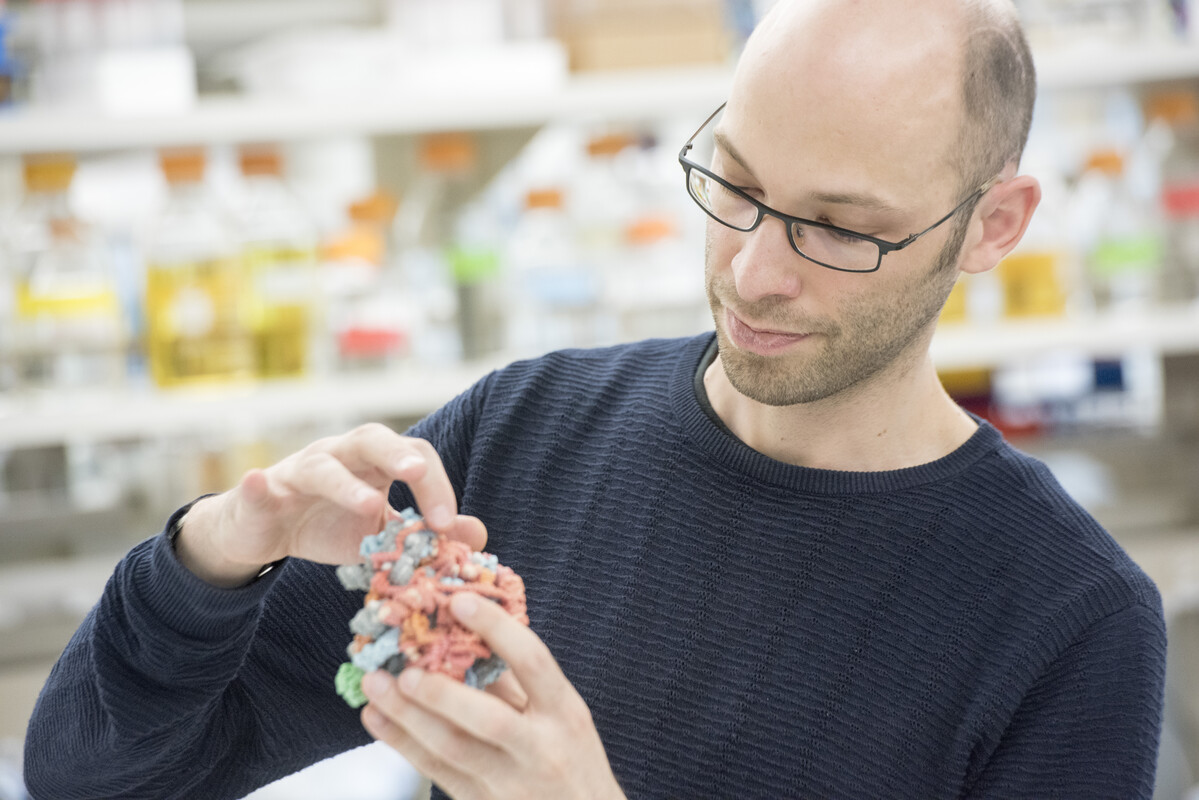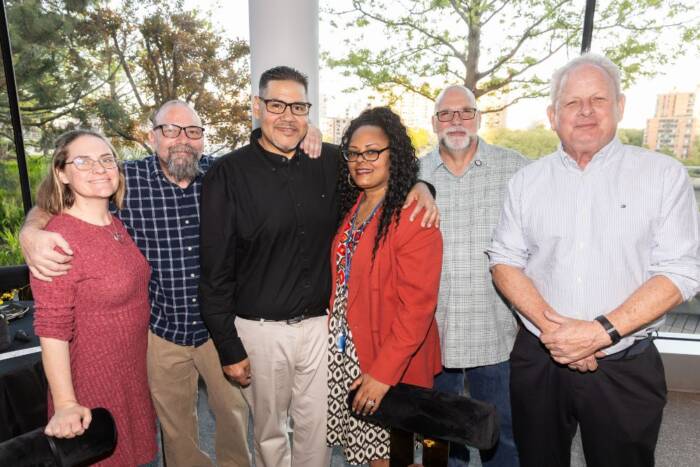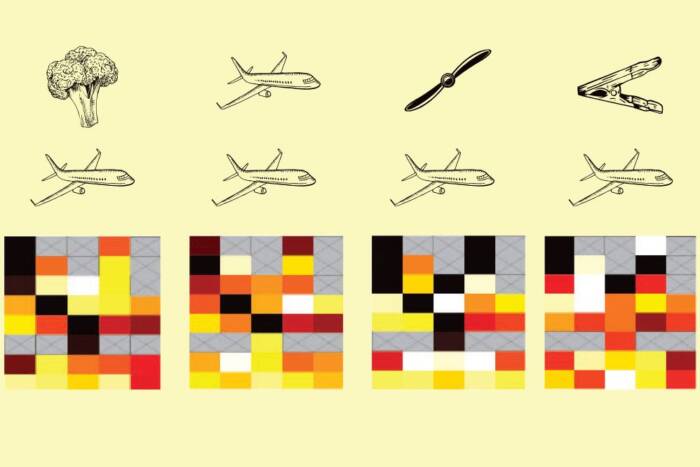Sebastian Klinge is racing to solve one of biology’s fundamental mysteries

Sebastian Klinge with a 3D-printed model of a large ribosomal subunit from a eukaryote, which his team was the first to solve.
If you’ve never heard of a “Palade particle,” you wouldn’t be alone. And yet its story is a familiar one in foundational biology: a newly identified object has a mysterious unknown function until dogged research reveals some of its secrets—then that research poses more questions than answers, and a new field emerges that changes the course of science.
That’s what happened in the 1950s, when Rockefeller’s George E. Palade discovered dense macromolecules clinging to membranes in the cytoplasm of cells. He had no idea what their purposes was, but their size was impressive, suggesting importance, and their appearance granular, suggesting assembly from subcomponents. As Palade and his colleagues would reveal in the coming decades, these particles—renamed “ribosomes” as researchers uncovered their connection to ribonucleic acids—turned out to be molecular machines that translate genetic code into the proteins that enable virtually every function in life. It would win him the 1974 Nobel Prize.
The story of the ribosome then progressed slowly but steadily for decades. It wasn’t until the early 2000s that X-ray crystallography began to reveal the first glimpses of a 3D, atomic-level structure of a complete prokaryotic ribosome. Researchers saw they had been on the right track in suspecting these impressively large molecules had unseen depths, layers, and structures, but visualizing these components has remained one of the most significant challenges in biology for almost 60 years, says Rockefeller’s Sebastian Klinge, head of the Laboratory of Protein and Nucleic Acid Chemistry(opens in new window). “From Palade’s discovery until relatively recently, we knew almost nothing about how ribosomes are assembled in eukaryotic systems,” he says. “They remained largely invisible to us at a structural level.”
That’s why Klinge’s work over the past decade to make the invisible visible has also made him a leading light in this field. Since coming to Rockefeller in 2013, the structural biologist has been on a quest to reveal how all 200 or so ribosomal assembly factors come together to form a functioning protein generator. So far, he has described dozens of formerly unknown assembly factors. His findings not only chip away at a fundamental biological mystery—how does the only known organic machine in existence build itself?—but also has major implications for human health. About a dozen disorders have been traced back to ribosomal dysfunction, and more are likely awaiting discovery.
Problem solver
Composed of coils of RNA and proteins, the ribosome is found in all domains of life, from bacteria and archaea to eukaryotes like yeast, tigers, beans, and us. Its job is to decode messenger RNA using its small subunit (known in eukaryotes as 40S) and then build proteins with its large subunit (60S). These subunits are themselves put together by assembly factors.
On Klinge’s desk sits a grapefruit-sized, color-coded, 3D-printed model of a large subunit. At its core are gray and blue coils representing its primordial appearance some 4 billion years ago with the evolution of bacteria. Overlaid are orange segments representing additions that came with archaea. Outermost—and most recent—are red bands representing eukaryote expansions.
As a teenager growing up near Hannover, Germany, Klinge hardly suspected that he would one day make breakthroughs that would enable such detailed modeling. He only knew he was fascinated by molecular biology. “It was very intuitive for me to really get nucleic acids and proteins. Understanding them seemed to be so easy for me—and so interesting,” he recalls.
As a high school student spending a year abroad in Bath, UK, he lit upon the idea of studying biochemistry at Cambridge. After returning to Germany to finish high school, he did exactly that.
The road to Rockefeller
In Cambridge in the early oughts, he attended lectures by luminaries like Venkatraman “Venki” Ramakrishnan, one of a trio of researchers whose work contributed to the first 3D atomic model of a prokaryotic ribosome, an advance that won him, Thomas Steitz, and Ada Yonath a Nobel Prize(opens in new window) in 2009.
Several years later as a postdoc at ETH-Zurich, Klinge found himself vying against Ramakrishnan and others to be the first to solve the structure of the eukaryotic ribosome. Klinge wasn’t the only one who found the scientific face-off exhilarating; several teams published multiple papers as a result of that effort. “If you know you’re under pressure because someone else is working on the same thing, you think, ‘Okay, I have things to do,’ and you get to work,” he says.
That painstaking effort involved trying to crystallize the large yet fragile molecule. Two years and thousands of shattered crystals later, his team finally succeeded, providing in 2011 the first atomic structure of a large ribosomal subunit of a eukaryote, which he plucked from a cilia-waving, unicellular organism called Tetrahymena thermophila. Though we may be distant kin to this protozoan, its ribosomal machinery is virtually identical to ours.
In 2013, he interviewed at Rockefeller in consideration of bringing his research to the university. On his interview schedule for the day was James Darnell. In the early 1960s, Darnell had determined that Palade particles, aka ribosomes, are initially synthesized from a long precursor RNA (which Darnell coined pre-ribosomal RNA) that is then cut into smaller pieces. This work paved the way for the study of RNA processing and human ribosome assembly.
“Rockefeller’s rich history in molecular biology, together with the freedom to pursue a deep basic research program, convinced me it was the right place for me,” Klinge says.
Filling in the gaps
When he arrived at Rockefeller later that year, cryo-EM—which images a molecule that has been suspended in a buffer solution and flash frozen—was just beginning to revolutionize structural biology, making it possible to reveal the structures of molecules in months rather than years. Rockefeller researchers, including Klinge, successfully advocated for the powerful machine to be installed at Rockefeller. They had to scramble to learn how to use it.
“My first paper here was also the first time I learned cryo-EM,” he says.
Since then, Klinge has reaped pre-ribosomal particles from both yeast and human cells and captured 3D snapshots of the many conformational and compositional changes they undergo—known as assembly intermediates—as they mature into fully functional ribosomes.
And yet many remain elusive, caught in an in-between space where technology has yet to let us peer. Klinge likens it to early, silent movies that today can play back in staccato fashion, their smooth transitions lost. “We have an emerging molecular movie of ribosome assembly, but some of the most important frames are missing,” he says. “I’m trying to fill in those blank spaces.”
Recently, his lab captured high-resolution cryo-EM structures of 24 human large ribosomal subunit assembly intermediates—precursors of the structure he was the first to solve. They also nailed down the human mitochondrial ribosome, which helps mitochondria produce proteins that manufacture ATP, the energy currency of the cell. A better understanding of mitoribosomes may have implications for diseases linked to their dysfunction, such as Perrault syndrome, which can cause hearing loss and ovarian dysfunction.
Implications for disease
Perhaps because of their intricacy, the slightest problem within these sophisticated machines can trigger numerous diseases with far-ranging effects, including poor bone formation, facial disfiguration, and dwarfism, among others. Ribosomopathy has also been linked to malignant cancers. More ribosomal disorders likely await discovery.
It’s also possible that some known diseases with unknown causes will link to a damaged assembly factor, as Klinge himself has shown. In one study of the small subunit of the human ribosome, for instance, he and his team discovered a protein that turned out to be a new assembly factor. Once they identified it, however, they realized it wasn’t an entirely unknown entity: mutations of the protein were known to cause cognitive disabilities.
“We were able to make a connection between things that were previously thought to be utterly remote from each other,” he says. “It’s remarkable that the subtlest change in the assembly of the ribosome can make such a fundamental difference.”
Considering the sheer complexity involved, the fact that things don’t go wrong more often is extraordinary. In his future research, Klinge intends to find out how this is achieved.
“We know that quality control must be maintained throughout the assembly process, but we don’t know how it’s done,” he says. “How does an assembly pathway sense that something has gone wrong? When and where is the quality-control process initiated? And how do we researchers spot the difference between a ribosome that’s being misassembled and one that’s just being slowly assembled? The answers to these questions will likely provide yet another series of questions for me to pursue.”



